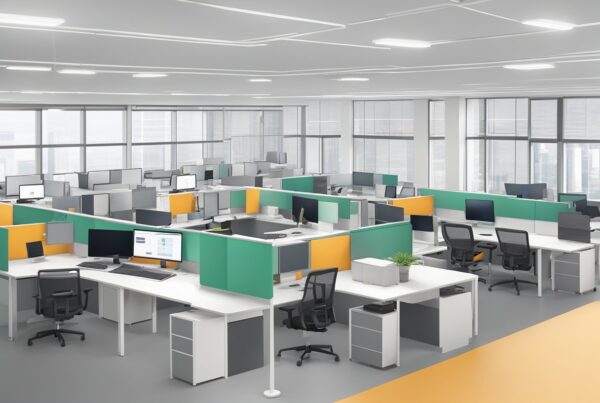As a property owner and operator, you want to have a good handle on critical areas such as:
- Profit and loss for each property and the whole portfolio
- Occupancy and leases
- Proper reporting to your investors as applicable
A lot of property managers deploy different point solutions to computerize the different aspect of their operations with a number of different programs. This includes stand-alone space management, lease management, financials and accounting as well as project management. There are also a lot of Excel files floating around for different purposes. While this approach helps in each of the automated area, these islands of automation require a lot of manual steps in import/export of the data from one system to another system. Also, you may end up working long hours in Excel in trying to come up with the reports you need. With each system having its interface and processes, you may end up being dependent on different people who would each be an expert in one of the systems but not necessarily in any of the others.An integrated system alleviates the above issues and streamlines the processes. However, such an integrated system needs to address the critical areas listed and explained below.
Property and Unit Management
As a property manager, it is important to have the information about your portfolio at your fingertips. Buildings their units, locations with an integration with Google maps for GIS and directions. You need to be able to query your portfolio and easily generate reports on short term and long term occupancy and expected income and expenses. The building and units need to have complete information with their valuation, assets, status of different elements such as roof, parking lot, etc. For each building you need to manage the team of internal and outside people involved with the operation such as property managers, vendors, brokers, etc. You need to be able access the floorplans online and easily drill down to the information you need or request services related to a location on a plan.
Lease Management
It is critical to have all leases properly abstracted in the system. Each lease needs to carry its terms (start and end date) as well as breakdown of the charges and deposits. You need to be able to easily setup free rent periods as well as landlord allowances. You also need to be able to manage the CAM (Common Area Maintenance) and any needed reconciliations. You need to receive timely notifications on all critical dates such as end of leases/renewals. Each notification should follow the term of notice in the lease and allow an additional grace period for the preparation of such notices. The system should easily create lease abstract reports as well as sending out notification letters for rent increases, terminations and other important communications with the tenants.
For leases, there needs to be automated process for implementing rent increases with the automated process for applying the agreed upon indices for increases (for example, increase based on CPI – Consumer Price Index). There should also be clear designation as the responsibility for different costs such as cleaning and fixing damages.
Various reports such as revenue projection over time, monthly expected variances should be easily available. Such reports need to auto-generate based on a desired schedule and to the responsible people.
The system should maintain a complete history of the lease with its finances and communications. You should be able to review any aspect of this history very easily at any time. Compliance with FASB lease capitalization would be a good feature since the standard is being rolled out over the next few years.
The monthly rent invoicing (if need be) and receipts need to be handled efficiently. For each tenant, the system needs to track any delinquency and apply the necessary fines and interest. Various collection and financing option for delinquent tenants need to be possible and easily available.
There also needs to be processes for managing provisions such as CAM collection and reconciliation as well as distributing costs for metered services (for example, energy and water) as well as collecting the tenants’ share for reserve funds. The system should also be able to manage the pass through costs (such as the repairs for which tenant is responsible for).
Maintenance Management
As a property owner and operator you are concerned about the well-being of the tenants as well as the health and the maintenance of the properties. The system needs to have an integrated maintenance management system (Computerized Maintenance Management System – CMMS) for collecting, tracking and handling any issues reported by the tenants or technicians. It also needs to provide tools for preventive (scheduled) maintenance and long term (deferred) maintenance. Different strategies such as working with in-house maintenance technicians or outside maintenance vendors or a combination of the two should be easily possible. Vendors need to be setup and managed for the system to select the correct vendor based on their location and expertise as well as their valid credentials such as insurance.
Tenants should be able to access the maintenance service request form using a portal or by calling or sending emails to designated mailboxes.
Finance and accounting – FASB and IASB capitalization
FASB (Financial … ) and its European equivalent (IASB) are upcoming requirements for managing leases in the near future. The essence of this requirement is that companies will be required to capitalize leases so that the leases will be captured on the balance sheets. The integrated lease management system needs to be prepared to handle the FASB/IASB requirements and comply with them.
It would also be necessary to have a complete general ledger capability in such a system with rigorous double entry accounting, AR & AP invoicing and management as well as various financial reports such trial balance, profit and loss (P&L) statements and balance sheet. This should be available for each property as well as any group of properties and the entire portfolio.
Portals for Tenants & Investors
As a property owner and operator, having portals for your tenants and investors would be very important.
Tenant portal – A good approach is to allow a login on the standard marketing site for tenants for accessing and entering their portal. On such a portal, a tenant will receive his/her statement, its status and will also be allowed to make a payment. They can also submit service request and also view the status of any previously submitted tickets.
Investor portal – The investor portal would allow the investors to check on the status of the properties they are involved with. An investor would need to see any combination of the following reports for their portfolio or an individual property.
- Profit & loss statement
- Balance sheet
- Current receipts and delinquencies
- Longer term projections
- Occupancy and vacancy reports
- Other specialized reports as needed
A system such as above would introduce a lot of efficiencies in an owner/operator environment. For more information of follow up discussion, please feel free to contact Axxerion to discuss this in more detail.







